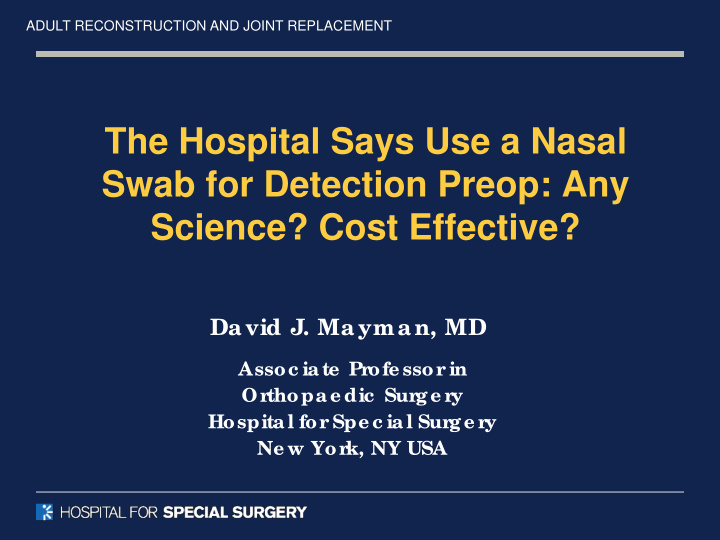



ADULT RECONSTRUCTION AND JOINT REPLACEMENT The Hospital Says Use a Nasal Swab for Detection Preop: Any Science? Cost Effective? David J. Mayman, MD Assoc iate Pr ofe ssor in Or thopae dic Sur ge r y Hospital for Spe c ial Sur ge r y Ne w Yor k, NY USA
Disclosures Consultant: Smith and Nephew OrthAlign Stock Options Imagen Stock Options ADULT RECONSTRUCTION AND JOINT REPLACEMENT
More Important Disclosure • I am not an epidemiologist • I am not an ID doc ADULT RECONSTRUCTION AND JOINT REPLACEMENT
Background: PJI • Prosthetic joint infection – Preventable – Morbid – Costly to patients, hospitals, society – PJI prevalence varies • By center • By subpopulation ADULT RECONSTRUCTION AND JOINT REPLACEMENT
Background • By 2020, an estimated 70,000 patients will require revision TJA due to PJI at a cost of $1.62 billion annually. 1 • Patients that are nasal carriers of S. aureus have up to a nine times higher risk of postoperative infection compared to a non-carrier. 2–4 • Methicillin-resistant Staphylococcus Aureus (MRSA) colonization is thought to be a risk factor for developing a PJI following TJA. 5,6 ADULT RECONSTRUCTION AND JOINT REPLACEMENT
Background: Prevention • How do we prevent PJI? – Patient selection – Pre-operative measures – Intra-operative practices – Post-operative care ADULT RECONSTRUCTION AND JOINT REPLACEMENT
Background: S. aureus • 30-40% of humans Anterior Nares are colonized with Pharynx MSSA or MRSA Axillae • Colonization Groin increases infection risk – Orthopedic, thoracic, and abdominal surgery – Intensive care Perl TM. Ann Pharmacother 1998;32:S7 Safdar N. Am J Med. 2008 Apr;121(4):310 Wenzel RP. J Hosp Infect 1995;31:13-24 ADULT RECONSTRUCTION AND JOINT REPLACEMENT
Background: Decolonization • Does decolonization actually work? – Studies differ. RCT data mostly lacking. – Methods vary (PCR vs culture, decolonization methods) – ID and Surgical preoperative guidelines don’t commit: IDSA CDC AAOS MSIS Bratzler DW. Surg Infect (Larchmt) 2013;14:73 AAOS Clinical Practice Guidelines. http://www.aaos.org/guidelines/?ssopc=1 Mangram AJ. Infect Control Hosp Epidemiol 1999;20:250 Parvizi J. J Arthroplasty. 2014;29(7):1331 ADULT RECONSTRUCTION AND JOINT REPLACEMENT
At our hospital: • Preoperative decolonization = – Five days of • Chlorhexidine gluconate 4% liquid once daily • Mupirocin 2% ointment to nose twice daily ADULT RECONSTRUCTION AND JOINT REPLACEMENT
ADULT RECONSTRUCTION AND JOINT REPLACEMENT Cost Effectiveness of Staphylococcus aureus Decolonization Strategies in High- Risk Total Joint Arthroplasty Patients
Objectives • To compare the cost-effectiveness of different strategies among high-risk arthroplasty patients – Using cost effectiveness decision analysis – From different payer viewpoints – Across a range of • Baseline PJI rates • Decolonization effectiveness levels ADULT RECONSTRUCTION AND JOINT REPLACEMENT
Methods • TreeAge software: analytic model • 5 strategies compared Strategy Practice Do No Screening, No treatment Nothing Treat All All patients decolonized 1S Nasal screening only 2S Nasal + 1 site 4S Nasal, pharynx, axillae, groin ADULT RECONSTRUCTION AND JOINT REPLACEMENT
Model Inputs % Staph prevalence 1. Baseline prevalence detected 40 – Swab data from 1,418 patients 35 – 28-34% rate of colonization – ~21% relative increase with 30 four swabs 34 31 25 – 33% (+) cultures were MRSA 28 20 1 2 4 Number of Swabs ADULT RECONSTRUCTION AND JOINT REPLACEMENT
Model Inputs 2. PJI incidence rates: literature 1 estimates – 1.3% in decolonized carriers after decolonization – 0.6% in non-carriers • (3.4% in untreated S. aureus carriers) 3. Costs: – $95 for mupirocin/chlorhexidine – $60 per swab culture ( = $240 for four cultures) 1. Hacek DM, et al, CORR 2008;466:1349 ADULT RECONSTRUCTION AND JOINT REPLACEMENT
Results Effective Treat All, and 4S $4,773 /PJI Cost Effective for Patient 2 swab strategy prevented Cost Effective for Hospital Treat All $0 Cost Effective for Society Treat All $14,229 ADULT RECONSTRUCTION AND JOINT REPLACEMENT
Sensitivity Analysis: Societal Perspective 1E+09 Incremental Cost Effectiveness Ratio 100000000 10000000 $ to prevent a PJI 1000000 Treat All 100000 Less Cost-Effective Nare + Pharynx 10000 Nare Do Nothing 1000 4 Swabs 100 10 1 PSSInotreat Increasing Baseline PJI Rate ADULT RECONSTRUCTION AND JOINT REPLACEMENT
Conclusions • More swabs = find more S. aureus. • More swabs ≠ more cost effectiveness. • Universal decolonization, as effective as 4S, is more cost effective from a society/payer perspective. • Cost effectiveness of decolonization increases when PJI rates increase. ADULT RECONSTRUCTION AND JOINT REPLACEMENT
Limitations • Regional variations not reflected. • Other strategies not evaluated. • Definitions of ‘high-risk’ vary. • Consequences and costs of excessive use of antiseptics not measured. – Bacterial resistance – Lack of MRSA monitoring ADULT RECONSTRUCTION AND JOINT REPLACEMENT
Take Home Points • Different strategies differ in cost effectiveness. • In our model, universal decolonization was broadly cost effective. • Universal decolonization could be highly cost effective in hospitals and among patient subgroups with average or higher PJI rates. ADULT RECONSTRUCTION AND JOINT REPLACEMENT
What Are We Doing Today? • Everyone gets a screening questionnaire • If they have had an MRSA infection, have a history of MRSA colonization or have a relative with a history of MRSA infection or colonization they get swabbed • If they are positive they get decolonization protocol before surgery • Even after decolonization they get dual antibiotic prophylaxis (Vancomycin and Ancef) ADULT RECONSTRUCTION AND JOINT REPLACEMENT
Thank you Special thank you to the following for their contribution to this talk: Andy O. Miller, MD Devin M. Williams, MPH Michael W. Henry, MD Geoffrey Westrich, MD Hassan M.K. Ghomrawi, PhD MPH ADULT RECONSTRUCTION AND JOINT REPLACEMENT
Recommend
More recommend